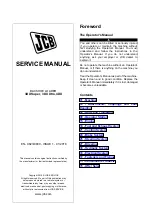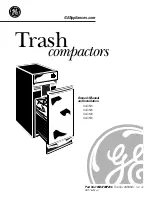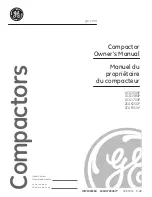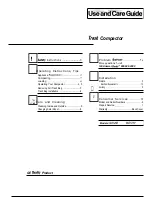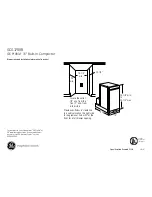
Attachments
Working with Attachments
90
9821/6100-4
90
Figure 76.
A
B
A
Female coupling
B
Male coupling
The quick release couplings will be trouble free and relatively easy to connect and disconnect, if they are kept
clean and used correctly. The recommendations listed below must always apply when using flat face quick
release couplings.
Read the correct connecting and releasing procedures before you install or remove any optional attachment
connected with quick release couplings.
Essential do's:
•
Before connecting or removing any hydraulic hose, the residual hydraulic pressure trapped in the service
hose line must be vented. Make sure the hose service line has been vented before connecting or removing
the hoses.
•
Always wipe the two mating faces clean before connecting.
•
Use caps and plugs when the couplings are disconnected.
•
Always align the external locking ball (if used) with the notch in the locking sleeve and then pull the locking
sleeve back fully to disconnect.
•
If a coupling sticks, first check that pressure has been released. Make sure the locking ball and notch
in the locking sleeve are aligned, pull back the sleeve and twist the couplings apart. Sticking is normally
caused by dirt in the coupling or physical damage due to abuse.
•
Connect and disconnect the new couplings two or three times to work the PTFE seals. Sometimes a new
coupling will stick if the seal has not been worked.
•
When connecting the couplings, only apply the spanner or grips to the hexagon and nowhere else.
•
Avoid damage to the coupling faces. Burrs and scratches cause damage to the seals and cause leaks.
They can also impede connection and disconnection of the couplings.
•
Periodically lubricate the internal locking balls on the female half of the coupling with silicone grease.
Essential don'ts:
•
Never try to reconnect using a damaged half coupling as this will destroy the seals in the mating half and
necessitate replacement of both halves.
•
Do not leave the coupling where it may be run over by a machine or otherwise crushed, this will distort
the sleeve and prevent connection and disconnection.
•
Never try to turn the sleeve when the coupling is disconnected as this will cause the locking ball to jam
under the locking sleeve and damage the coupling.
•
Never try to strip the coupling down, there are no user serviceable parts. If the coupling is damaged it
must be replaced with a new one.
•
Never hit the centre poppet of the coupling to try and release the locked in pressure. This can cause
irreparable damage to the coupling and serious injury.
•
When connecting the couplings, never clamp on the sleeve of the female or nose of the male, this will
cause distortion and/or damage.
•
Never subject the couplings to external forces, especially side load. This can decrease the life of the
coupling or cause failure.
•
Never allow the torsional forces transmitted from the hoses to unscrew/screw together the couplings.
•
Never use a coupling as a plug.
•
Do not connect and disconnect with pressure in the line unless the coupling type is specifically designed
to do so.
Connecting Quick Release Couplings
1. Remove any residual hydraulic pressure trapped in the service line hose.
2. Wipe the two faces of the male and female couplings and make sure they are clean.
3. Make sure that ball in the female coupling is located in one of its slots.
Summary of Contents for 2069289
Page 2: ......
Page 4: ...9821 6100 4 Notes...
Page 12: ...Notes viii 9821 6100 4 viii...
Page 18: ...Notes 6 9821 6100 4 6...
Page 30: ...Notes 18 9821 6100 4 18...
Page 45: ...Operation Windows 33 9821 6100 4 33 Figure 21 A B A Latch B Frame...
Page 98: ...Notes 86 9821 6100 4 86...
Page 207: ...Technical Data Warranty Information 195 9821 6100 4 195 Figure 154 11000h 132 Month h...
Page 208: ...Notes 196 9821 6100 4 196...































